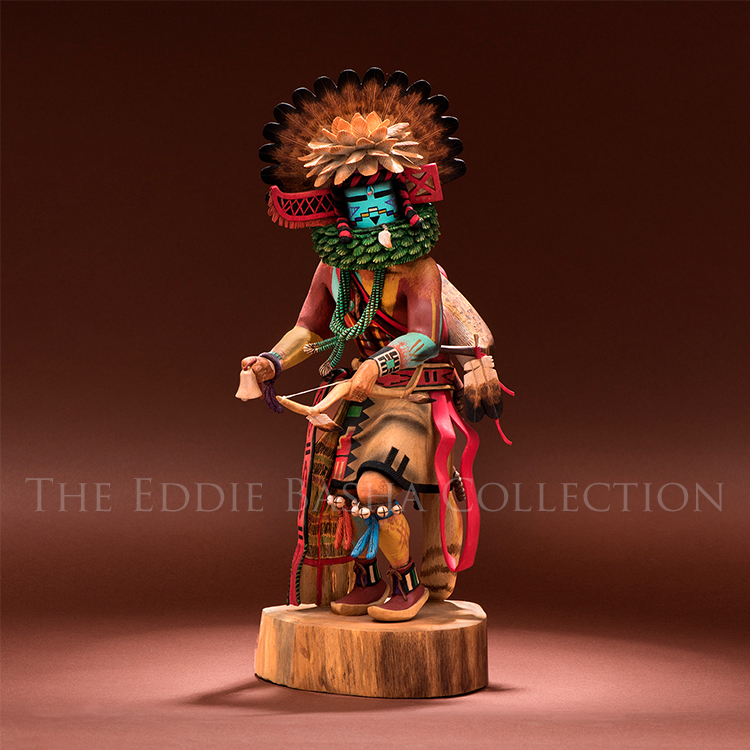Adrian Nasafotie

Supai Uncle
Artist: Adrian Nasafotie
Description: Cottonwood Root | Dimensions: 19”h x 7”wsculpture
Tuba City born Hopi katsina carver Adrian Nasafotie was raised in Moencopi and Shongopavi. He learned by watching his father Frazier Nasafotie and uncles carve. Adrian completed his first full figure Katsina at the early age of nine. Following the Hopi tradition, he was taught the Katsina doll represents not only the Katsina dancer, but is also used as a teaching tool of the Hopi to respect self and all living things. According to Adrian, the Katsinam allow the Hopi to teach others to live harmoniously and to appreciate life’s simplicities. And through his art, Adrian does just that.
The Supai Uncle represents the Havasupai people who live at the bottom of Havasu Canyon. This katsina appears usually during the water kiva ceremonies or during the spring and summer ceremonies and dances beside other katsinam.
 Cottonwood Root | Dimensions: 19”h x 7”w
Cottonwood Root | Dimensions: 19”h x 7”wTuba City born Hopi katsina carver Adrian Nasafotie was raised in Moencopi and Shongopavi. He learned by watching his father Frazier Nasafotie and uncles carve. Adrian completed his first full figure Katsina at the early age of nine. Following the Hopi tradition, he was taught the Katsina doll represents not only the Katsina dancer, but is also used as a teaching tool of the Hopi to respect self and all living things. According to Adrian, the Katsinam allow the Hopi to teach others to live harmoniously and to appreciate life’s simplicities. And through his art, Adrian does just that.
The Supai Uncle represents the Havasupai people who live at the bottom of Havasu Canyon. This katsina appears usually during the water kiva ceremonies or during the spring and summer ceremonies and dances beside other katsinam.
Supai Uncle
Artist: Adrian Nasafotie
Description:
Cottonwood Root | Dimensions: 19”h x 7”w
Tuba City born Hopi katsina carver Adrian Nasafotie was raised in Moencopi and Shongopavi. He learned by watching his father Frazier Nasafotie and uncles carve. Adrian completed his first full figure Katsina at the early age of nine. Following the Hopi tradition, he was taught the Katsina doll represents not only the Katsina dancer, but is also used as a teaching tool of the Hopi to respect self and all living things. According to Adrian, the Katsinam allow the Hopi to teach others to live harmoniously and to appreciate life’s simplicities. And through his art, Adrian does just that.
The Supai Uncle represents the Havasupai people who live at the bottom of Havasu Canyon. This katsina appears usually during the water kiva ceremonies or during the spring and summer ceremonies and dances beside other katsinam.
sculptureTuba City born Hopi katsina carver Adrian Nasafotie was raised in Moencopi and Shongopavi. He learned by watching his father Frazier Nasafotie and uncles carve. Adrian completed his first full figure Katsina at the early age of nine. Following the Hopi tradition, he was taught the Katsina doll represents not only the Katsina dancer, but is also used as a teaching tool of the Hopi to respect self and all living things. According to Adrian, the Katsinam allow the Hopi to teach others to live harmoniously and to appreciate life’s simplicities. And through his art, Adrian does just that.
The Supai Uncle represents the Havasupai people who live at the bottom of Havasu Canyon. This katsina appears usually during the water kiva ceremonies or during the spring and summer ceremonies and dances beside other katsinam.